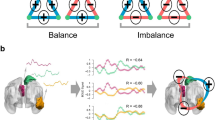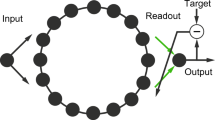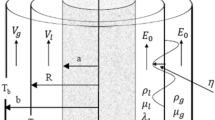Abstract
The human brain1,2, power grids3, arrays of coupled lasers4 and the Amazon rainforest5,6 are all characterized by multistability7. The likelihood that these systems will remain in the most desirable of their many stable states depends on their stability against significant perturbations, particularly in a state space populated by undesirable states. Here we claim that the traditional linearization-based approach to stability is too local to adequately assess how stable a state is. Instead, we quantify it in terms of basin stability, a new measure related to the volume of the basin of attraction. Basin stability is non-local, nonlinear and easily applicable, even to high-dimensional systems. It provides a long-sought-after explanation for the surprisingly regular topologies8,9,10 of neural networks and power grids, which have eluded theoretical description based solely on linear stability11,12,13. We anticipate that basin stability will provide a powerful tool for complex systems studies, including the assessment of multistable climatic tipping elements14.
This is a preview of subscription content, access via your institution
Access options
Subscribe to this journal
Receive 12 print issues and online access
$259.00 per year
only $21.58 per issue
Buy this article
- Purchase on SpringerLink
- Instant access to full article PDF
Prices may be subject to local taxes which are calculated during checkout




Similar content being viewed by others
References
Babloyantz, A. & Destexhe, A. Low-dimensional chaos in an instance of epilepsy. Proc. Natl. Acad. Sci. USA 83, 3513–3517 (1986).
Lytton, W. W. Computer modelling of epilepsy. Nature Rev. Neurosci. 9, 626–637 (2008).
Machowski, J., Bialek, J. W. & Bumby, J. R. Power System Dynamics: Stability and Control (Wiley, 2008).
Erzgräber, H. et al. Mutually delay-coupled semiconductor lasers: Mode bifurcation scenarios. Opt. Commun. 255, 286–296 (2005).
Da Silveira Lobo Sternberg, L. Savanna-forest hysteresis in the tropics. Glob. Ecol. Biogeogr. 10, 369–378 (2001).
Hirota, M., Holmgren, M., Van Nes, E. H. & Scheffer, M. Global resilience of tropical forest and savanna to critical transitions. Science 334, 232–235 (2011).
May, R. M. Thresholds and breakpoints in ecosystems with a multiplicity of stable states. Nature 269, 471–477 (1977).
Watts, D. J. & Strogatz, S. H. Collective dynamics of ‘small-world’ networks. Nature 393, 440–442 (1998).
Sporns, O. & Zwi, J. The small world of the cerebral cortex. Neuroinformatics 2, 145–162 (2004).
Wang, Z., Scaglione, A. & Thomas, R. J. Generating statistically correct random topologies for testing smart grid communication and control networks. IEEE Trans. Smart Grid 1, 28–39 (2010).
Pecora, L. M. & Carroll, T. L. Master stability functions for synchronized coupled systems. Phys. Rev. Lett. 80, 2109–2112 (1998).
Barahona, M. & Pecora, L. M. Synchronization in small-world systems. Phys. Rev. Lett. 89, 054101 (2002).
Hong, H., Kim, B. J., Choi, M. Y. & Park, H. Factors that predict better synchronizability on complex networks. Phys. Rev. E 69, 067105 (2004).
Lenton, T. M. et al. Tipping elements in the earth’s climate system. Proc. Natl. Acad. Sci. USA 105, 1786–1793 (2008).
Nusse, H. E. & Yorke, J. A. Basins of attraction. Science 271, 1376–1380 (1996).
Wiley, D. A., Strogatz, S. H. & Girvan, M. The size of the sync basin. Chaos 16, 015103 (2006).
Scheffer, M. et al. Early-warning signals for critical transitions. Nature 461, 53–59 (2009).
Van Nes, E. H. & Scheffer, M. Slow recovery from perturbations as a generic indicator of a nearby catastrophic shift. Am. Nature 169, 738–747 (2007).
Holling, C. S. Resilience and stability of ecological systems. Annu. Rev. Ecol. Syst. 4, 1–23 (1973).
Scheffer, M. Critical Transitions in Nature and Society (Princeton Univ. Press, 2009).
Boccaletti, S., Latora, V., Moreno, Y., Chavez, M. & Hwang, D-U. Complex networks: Structure and dynamics. Phys. Rep. 424, 175–308 (2006).
Buldyrev, S. V., Parshani, R., Paul, G., Stanley, H. E. & Havlin, S. Catastrophic cascade of failures in interdependent networks. Nature 464, 1025–1028 (2010).
Arenas, A., Díaz-Guilera, A., Kurths, J., Moreno, Y. & Zhou, C. Synchronization in complex networks. Phys. Rep. 469, 93–153 (2008).
Fries, P. A mechanism for cognitive dynamics: neuronal communication through neuronal coherence. Trends Cogn. Sci. 9, 474–480 (2005).
Fell, J. et al. Human memory formation is accompanied by rhinal-hippocampal coupling and decoupling. Nature Neurosci. 4, 1259–1264 (2001).
Fell, J. & Axmacher, N. The role of phase synchronization in memory processes. Nature Rev. Neurosci. 12, 105–118 (2011).
Hammond, C., Bergman, H. & Brown, P. Pathological synchronization in Parkinson’s disease: Networks, models and treatments. Trends Neurosci. 30, 357–364 (2007).
Huang, S. & Ingber, D.E. A non-genetic basis for cancer progression and metastasis: Self-organizing attractors in cell regulatory networks. Breast Disease 26, 27–54 (2007).
Lovász, L. & Vempala, S. Simulated annealing in convex bodies and an volume algorithm. J. Comput. Syst. Sci. 72, 392–417 (2006).
Li, G. et al. Towards design principles for optimal transport networks. Phys. Rev. Lett. 104, 018701 (2010).
Acknowledgements
The authors acknowledge financial support from IRTG 1740 (Deutsche Forschungsgemeinschaft), the SUMO-project (European Union), the ECONS-project (Leibniz Association) and Konrad-Adenauer-Stiftung. They thank N. Fujiwara and A. Rammig for inspiring discussions.
Author information
Authors and Affiliations
Contributions
P.J.M. conceived the study, performed the numerics, and prepared the manuscript. All authors discussed the results, drew conclusions and edited the manuscript. J.K. supervised the study.
Corresponding author
Ethics declarations
Competing interests
The authors declare no competing financial interests.
Supplementary information
Supplementary Information
Supplementary Information (PDF 1035 kb)
Rights and permissions
About this article
Cite this article
Menck, P., Heitzig, J., Marwan, N. et al. How basin stability complements the linear-stability paradigm. Nature Phys 9, 89–92 (2013). https://doi.org/10.1038/nphys2516
Received:
Accepted:
Published:
Issue date:
DOI: https://doi.org/10.1038/nphys2516
This article is cited by
-
Structure of parameter space of a three-species food chain model with immigration and emigration
Nonlinear Dynamics (2023)
-
Complex dynamics of a conceptual airfoil structure with consideration of extreme flight conditions
Nonlinear Dynamics (2023)
-
Vulnerable Waters are Essential to Watershed Resilience
Ecosystems (2023)
-
Alternative stable ecological states observed after a biological invasion
Scientific Reports (2022)
-
Recovery coupling in multilayer networks
Nature Communications (2022)



